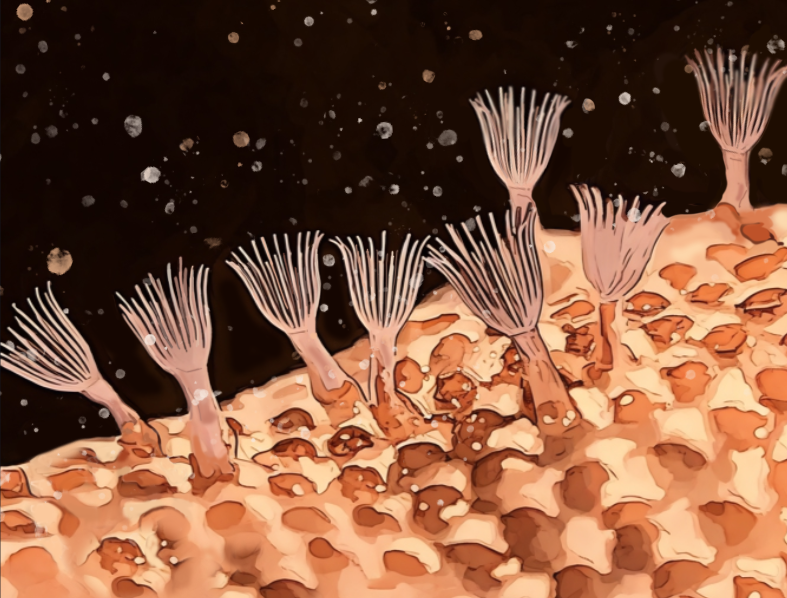
I was in Monterey over the summer, surrounded by humpback whales, pelicans, sea lions, and rockfish. The area blossomed with diversity and wildlife from sunrise to sunset. However, one thing in particular caught my eye. My first encounter was under a microscope at Moss Landing. With the naked eye, it was just a life-less-looking spiny brown strand with thin branches. It looked wilted or the remnants of something. Little did I know that when I put it under the microscope, I would discover some of the most fascinating creatures. Bryozoans.
They are abundant. They are everywhere. Some look like sponges. Some look like algae, seaweed, or even coral. But what exactly are they?
Bryozoans are actually small invertebrates. These individual animals are called zooids, which expand into colonies of thousands and thousands. These colonial animals are sessile. Once they test the surface, they cement themselves to the substrate, which can be something like a kelp blade. We usually see them clustered under docks or on rocky shores.
Biology

Each zooid is made up of a calcified body wall and a polypide, which is the soft part of the body consisting of a lophophore, gut, muscles, and nerves. I found the lophophore to be the most intriguing, both in literature and under the microscope. Lophophores are essentially organs with U-shaped ciliated tentacle crowns, used by these animals to create currents and capture microorganisms like protozoa or algae in the water for food. These creatures used these tentacles to catch their food, much like other brachiopods that filter feed. I watched them flicker and dance in the water majestically. I felt like I was witnessing the music and rhythm of the ocean that is so often neglected at the microscopic level.
Reproduction
Bryozoans have the most intriguing reproductive processes. They are hermaphroditic, meaning they have both male and female reproductive organs, structures, gametes, and tissues. Thus, they reproduce both sexually and asexually.
Sexual reproduction begins with bryozoan eggs and sperm shed into the water to fuse. The tentacles of the lophophore capture free-floating sperm in the water to fertilize the eggs. The eggs are brood in chambers called ovicells until they become larvae. The free-swimming larvae eventually settle on a substrate like kelp and metamorphose into a new zooid. From there, it expands into a colony.
If a fragment of a zooid is broken, this fragment can continue growing and also form new colonies. Bryozoan asexual reproduction allows its colonies to grow rapidly across substrates.
Diversity
There are so many kinds of bryozoans. In fact, all 6,000 species vary in size, shape, depth, and growth forms. Growth forms vary from encrusting, palmate, branched, fenestrate, articulate, and arborescent to foliose. For example, some of them encrust expansive colonies on hard artificial substrates like docks. Others attach to seaweed, sand grain, or sediment. They provide habitats for crustaceans, mussels, and nematodes and also are food sources for nudibranchs and sea spiders.
Chemoecology
But what I found most interesting about these lophotrochozoan animals was their potential for chemoecology. Marine organisms are being increasingly used for scientific studies to develop pharmaceutical and biomedical compounds. Bryozoans are specifically being studied for anticancer activity.
Out of the 6,000 species of Bryozoa, only 26 species have been used to isolate more than 230 compounds. If more species were examined, just think about the number of compounds we could extract and use for medical pursuits and research.
One species in particular, the Bugula Neritina, has been studied to produce a y-proteobacterium symbiont named “Candidatus Endobugula sertula” which produces cytotoxic compounds called bryostatins. Bryostatins are created as a chemical defense for the larvae. What researchers discovered about Bryostatin-1 is that it kills ABCB5, which is an ATP-binding cassette transporter for the subfamily B and member 5, and down-regulates MDR1 gene expression (Al-Katib et al., 1998). What exactly is MDR1 gene expression, and what are its implications for cancer? The MDR1 gene for multidrug resistance is overexpressed in certain cancers like lung cancer, giving rise to multi-drug resistance phenotypes. Researchers discovered that this compound derived from bryozoans downregulates the expression of this very gene.
Bryozoans hold much promise for the future of marine-derived compounds of medicine, including post-stroke treatment, Alzheimer’s, pro-apoptotic stimuli in brain cancer, and more.
These creatures are everywhere yet so unexplored. They hold incredible potential for biomedical sciences and play an important role in marine ecosystems.
References
Al-Katib, A. M., Smith, M. R., Kamanda, W. S., Pettit, G. R., Hamdan, M., Mohamed, A. N., Chelladurai, B., & Mohammad, R. M. (1998). Bryostatin 1 down-regulates mdr1 and potentiates vincristine cytotoxicity in diffuse large cell lymphoma xenografts. Clinical Cancer Research : An Official Journal of the American Association for Cancer Research, 4(5), 1305–1314. https://pubmed.ncbi.nlm.nih.gov/9607591/
Bryozoan. (2021). Montereybayaquarium.org. https://www.montereybayaquarium.org/animals/animals-a-to-z/bryozoan
Ciavatta, M. L., Lefranc, F., Vieira, L. M., Kiss, R., Carbone, M., van Otterlo, W. A. L., Lopanik, N. B., & Waeschenbach, A. (2020). The Phylum Bryozoa: From Biology to Biomedical Potential. Marine Drugs, 18(4), 200. https://doi.org/10.3390/md18040200
Haderlie, E. C. (2024). Details – Biology and ecology of encrusting bryozoans in Monterey Harbor – Biodiversity Heritage Library. Biodiversitylibrary.org. https://www.biodiversitylibrary.org/bibliography/62519
Lonhart, S.I. 2012. Growth and Distribution of the Invasive Bryozoan Watersipora in Monterey Harbor, California. In: D.L. Steller and L.K. Lobel (editors), Diving for Science 2012. Proceedings of the American Academy of Underwater Sciences 31st Scientific Symposium. American Academy of Underwater Sciences, Dauphin Island, Alabama. p. 89-98.
MBNMS: Growth and Distribution of the Invasive Bryozoan Watersipora in Monterey Harbor, California. (n.d.). Montereybay.noaa.gov. https://montereybay.noaa.gov/research/techreports/trlonhart2012.html
Pinnix, J. (2023). Bryozoans | U.S. Fish & Wildlife Service. Www.fws.gov. https://www.fws.gov/story/bryozoans
Spangler, R. (2024). Monterey Area Bryozoans. Spanglers’ Scuba. https://scuba.spanglers.com/marine-life/monterey-area/bryozoans
The views and opinions expressed are those of the authors and do not necessarily reflect nor represent the Earth Chronicles and its editorial board.




